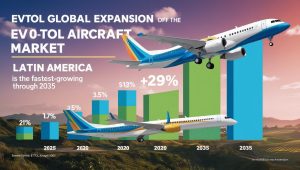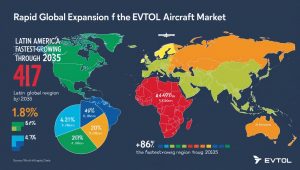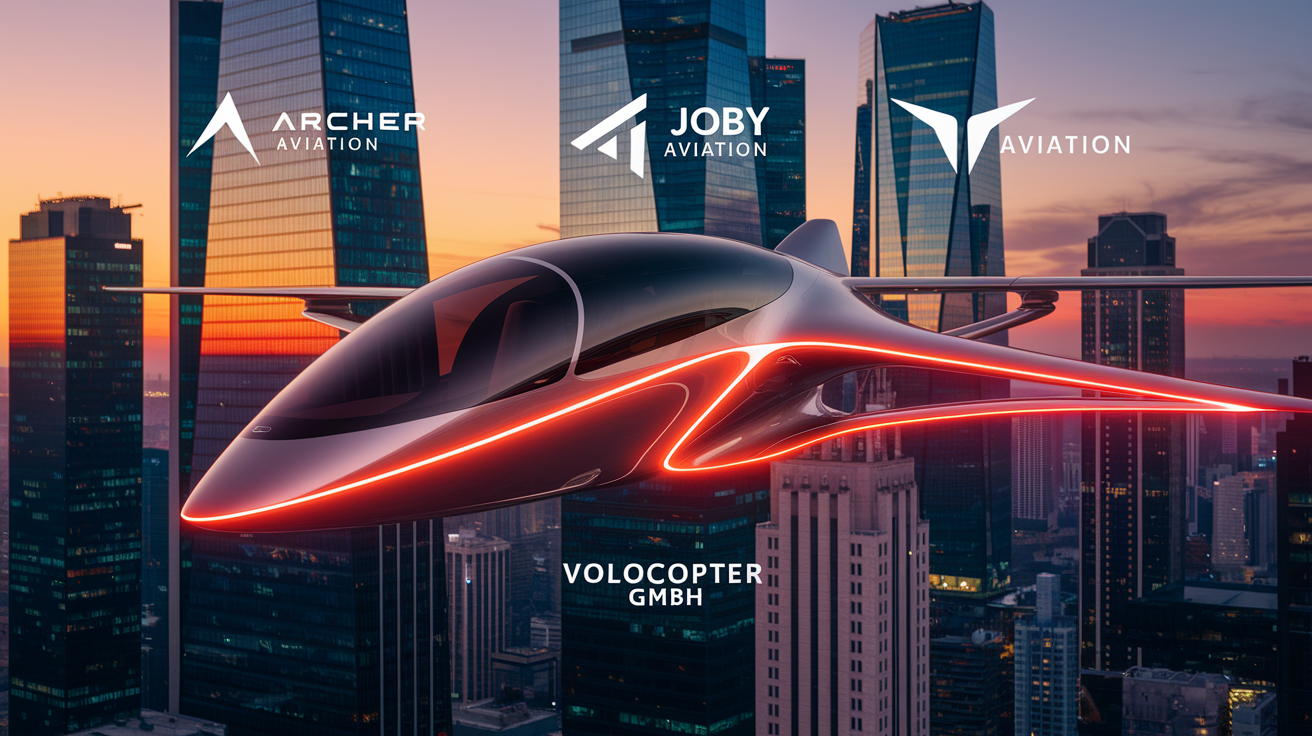The Electric Vertical Takeoff and Landing (eVTOL) Aircraft Market is witnessing rapid global expansion, and Latin America is emerging as the fastest-growing region through 2035. With a projected Compound Annual Growth Rate (CAGR) surpassing global averages, the region presents a compelling case for investment, infrastructure development, and policy innovation in advanced air mobility (AAM).
1. Regional Growth Drivers
Several macro and microeconomic factors uniquely position Latin America to experience accelerated eVTOL adoption:
a) Urban Congestion and Infrastructure Gaps
Major cities such as São Paulo, Mexico City, Bogotá, and Lima suffer from some of the world’s worst traffic congestion. Traditional transport systems are overstressed, inefficient, and in many cases, underdeveloped. eVTOLs offer a fast, scalable alternative for urban mobility and regional connectivity.
b) Geographic and Topographic Complexity
Latin America’s geography includes mountainous terrain, dense rainforests, and widespread archipelagos (e.g., the Amazon Basin, Andes, Patagonia), which complicate ground-based transportation. eVTOLs can bridge these gaps efficiently, connecting rural or remote areas to urban centers with minimal infrastructure investment.
c) Growing Middle Class and Urbanization
Rapid urbanization, paired with an expanding middle class, is creating a strong demand for innovative, premium transport solutions. This demographic shift aligns with early adopters of eVTOL technologies, particularly for use cases like air taxis and medical transport.
2. Key Applications of eVTOLs in Latin America
a) Urban Air Mobility (UAM)
Cities like São Paulo are already hubs for helicopter commuting, setting a cultural and logistical precedent for eVTOL deployment. With quieter, more affordable electric aircraft, eVTOLs can democratize air commuting and move beyond the wealthy elite.
b) Regional Air Mobility (RAM)
Large rural regions with limited or poor road connectivity will benefit significantly from short-haul eVTOL routes for passengers, cargo, and medical supplies.
c) Emergency Medical Services (EMS) and Disaster Relief
eVTOLs provide rapid access in disaster-prone regions (earthquakes, floods, landslides), enabling agile responses. Countries like Chile and Colombia have already explored drone delivery and helicopter-based EMS, making them prime candidates for eVTOL integration.
3. Government Initiatives and Regulatory Readiness
a) Proactive Civil Aviation Authorities
Countries like Brazil and Mexico have civil aviation agencies (ANAC and AFAC, respectively) that are open to working with global and regional eVTOL manufacturers to define standards and airspace integration strategies.
b) Public-Private Partnerships
Initiatives similar to Brazil’s Eve Air Mobility collaboration with Embraer and local infrastructure providers are paving the way for broader regulatory frameworks, including vertiport planning and UAM traffic corridors.
c) Cross-border Integration Potential
Given Latin America’s tight regional ties, the development of cross-border eVTOL corridors (e.g., between Colombia and Panama or Brazil and Argentina) could set a global precedent in regional air mobility agreements.
4. Key Players and Market Entry Strategies
a) Eve Air Mobility (Brazil)
Backed by Embraer, Eve is Latin America’s flagship eVTOL startup, with strategic plans to launch operations in Brazil and beyond. Their focus includes urban taxi services and cargo delivery, targeting launch timelines in the late 2020s.
b) Joby Aviation and Volocopter
While headquartered in the U.S. and Germany respectively, both companies are targeting Latin American cities due to favorable market conditions, regulatory openness, and infrastructure demand.
c) Local Vertiport Developers
Real estate and infrastructure companies across Latin America are beginning to invest in vertiport hubs on rooftops of hotels, malls, and hospitals, particularly in São Paulo, Rio, and Santiago.
5. Challenges to Address
Despite its potential, the Latin American eVTOL market faces specific hurdles:
-
Regulatory Complexity: Varying regulations across countries could slow cross-border UAM deployment.
-
Economic Volatility: Currency fluctuations and political instability may affect long-term investment confidence.
-
Infrastructure Gaps: While demand is high, many urban centers lack the basic infrastructure to immediately support eVTOL deployment without significant public investment.
6. Future Outlook
By 2030–2035, Latin America is expected to:
-
Become a global leader in regional air mobility for remote access and cross-border transport.
-
Pioneer low-cost eVTOL applications tailored for middle-income markets.
-
Set an example for other developing regions on how to leapfrog traditional infrastructure with next-generation aerial transport.
Analysts forecast that Latin America will capture a significant share of the projected $17.34 billion global eVTOL market, driven by strong domestic demand and its strategic position in global aviation trends.
Latin America’s rise in the eVTOL market is not merely a regional trend—it’s a signal of global aviation’s future moving toward inclusive, efficient, and sustainable air mobility solutions. With the right regulatory support, public-private coordination, and technological integration, Latin America could be a blueprint for emerging-market success in eVTOL deployment.
The Rise of eVTOL Aircraft in North America and Its Impact on the Future of Urban Mobility
Visit LinkedIn Page : MarketsandMarkets™ – Aerospace & Defense Research



